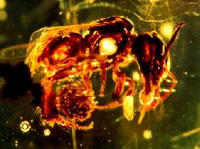| Sturdy microbes | 2003-02-08 23:59 0 comments |
 by Flemming Funch by Flemming FunchI think the world of microbial organisms is really fascinating. For example, there have been various discoveries of how amazingly sturdy microbes can be, and how they can survive in what we would consider the most inhospitable environments. Just recently, scientists discovered that there is plenty of life even deep below the ocean floor. They sampled 3.5 million year old crust 1000 feet below the bottom of the Pacific Ocean. There is an enormous pressure, and none of the normal energy sources that life depends on. But different microbes exist there. Another story here , about rock-eating microbes on the sea floor. It estimates that 10-30% of the Earth's bio-mass consists of microbes deep inside the crust. Bacteria also have amazing abilities to survive for a long time under extreme conditions in a suspended state. On April 20, 1967, the unmanned lunar lander Surveyor 3 landed near Oceanus Procellarum on the surface of the moon. One of the things aboard was a television camera. Two-and-a-half years later, on November 20, 1969, Apollo 12 astronauts Pete Conrad and Alan L. Bean recovered the camera. When NASA scientists examined it back on Earth they were surprised to find specimens of Streptococcus mitis that were still alive. Because of the precautions the astronauts had taken, NASA could be sure that the germs were inside the camera when it was retrieved, so they must have been there before the Surveyor 3 was launched. These bacteria had survived for 31 months in the vacuum of the moon's atmosphere. Perhaps NASA shouldn't have been surprised, because there are other bacteria that thrive under near-vacuum pressure on the earth today. Anyway, we now know that the vacuum of space is not a fatal problem for bacteria.Or, even more wild, 30 million year old bacteria have survived in amber: Biologists Raœl Cano and Monica Borucki had extracted bacterial spores from bees preserved in amber in Costa Rica. Amber is tree-sap that hardens and persists as a fossil. This amber had entrapped some bees and then hardened between 25 and 40 million years ago. Bacteria living in the bees' digestive tracts had recognized a problem and turned themselves into spores. When placed in a suitable culture, the spores came right back to life.Those last two are from Cosmic Ancestry, a very interesting site supporting the possibility that life on Earth has been seeded from space. Here's another recent article about that, suggesting that life probably exists now on Mars, under similar conditions as what we find in the Earth's crust, and that it is quite likely that the process here was seeded by microbes from Mars. |